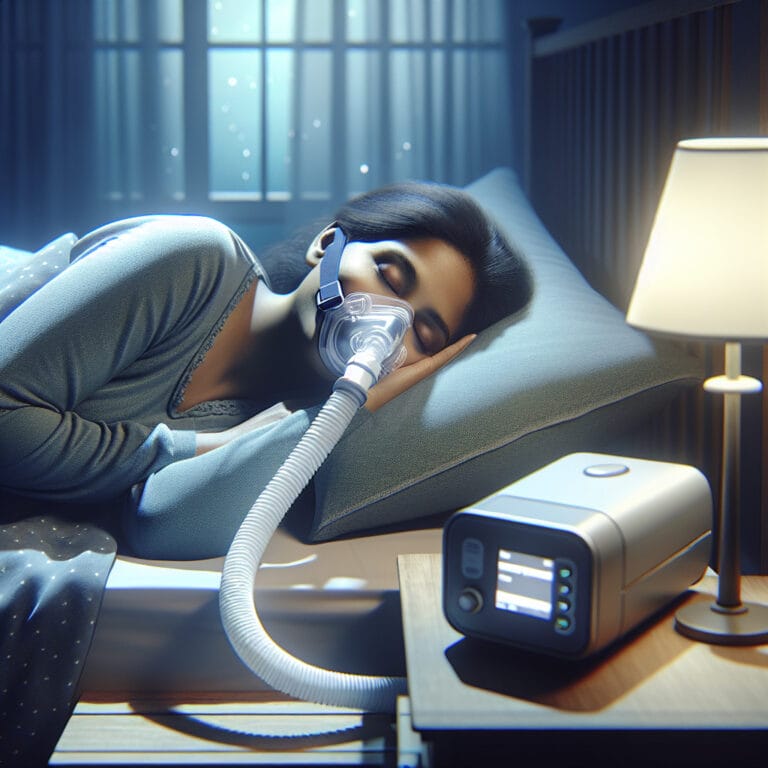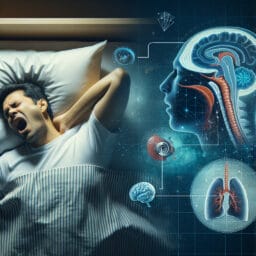
Understanding the Definition and Benefits of Continuous Positive Airway Pressure (CPAP)
Table of Contents
Introduction
It is noteworthy that Continuous Positive Airway Pressure (CPAP) therapy has emerged as a lifesaver for many people battling sleep apnea, specifically Obstructive Sleep Apnea (OSA). A CPAP machine works by generating a set pressure of forced air, delivered via a face mask and expiratory tubing to keep your airways open during your sleep cycle. This positive pressure can significantly improve sleep quality, leading to increased alertness during the day and better overall health. Studies reveal that optimal function of CPAP machines can help in mitigating health issues including heart disease related to poor sleep or interrupted respiratory cycles. Furthermore, adjusting the pressure settings on the CPAP device according to a patient’s needs—based on findings from an extensive sleep study conducted by a sleep specialist—can enhance its effectiveness remarkably. The inclusion of components such as an air filter and humidifier chamber in modern CPAP machines further enriches their usability by ensuring good seal and reducing any adverse effects respectively. It’s also important to remember that using distilled water for these machines can prolong their life span while avoiding potential damage. In essence, embracing CPAP treatment provides more than just good night’s rest; it paves the way for improved overall wellbeing too.
Defining CPAP
Did you know that a CPAP machine, with its constant stream of forced air delivered through an expiratory tubing mask, can significantly improve sleep quality and help alleviate the symptoms of even severe cases of obstructive sleep apnea (OSA)? This incredible device works by maintaining a positive pressure in the airways during your sleep cycle, essentially acting as an “air splint” to keep your respiratory system open. A specialist at a sleep center adjustment session or during a thorough sleep study will determine the set level or pressure settings for your CPAP machine. This precise calibration ensures optimal function of CPAP machines for each individual patient – a testament to their personalized approach.
The intricate components of this device deserve mention too. The heart of any CPAP machine is its motor which blows air into the tubing mask at the set pressure. An integrated air filter removes impurities and allergens from this blown air, ensuring cleaner and healthier breathing while asleep. To enhance comfort, most modern variants also include a humidifier chamber that adds moisture to the otherwise dry air thereby reducing possible adverse effects such as nasal congestion or throat irritation.
Patients often worry about maintaining good seal with face masks – but rest assured, manufacturers have taken great strides to increase comfort without sacrificing efficacy. There are numerous styles available today designed to accommodate varying facial structures and personal preferences – from full-face masks covering both nose and mouth to more minimalistic nasal pillows.
Moreover, these machines are designed for easy maintenance – regular replacement of parts like filters and distilled water usage in humidifiers can extend their longevity considerably. Through consistent use alongside lifestyle modifications suggested by doctors like weight management or quitting smoking, patients can effectively manage sleep apnea symptoms with this noninvasive positive pressure ventilation (NPPV) method known as CPAP therapy.
In treating people suffering from OSA or central sleep apnea alike, it’s clear that continuous positive airway pressure (CPAP) has emerged not just as a sleep aid, but a tool for overall health improvement – including potential reduction of related health issues like heart disease. Indeed, the benefits of CPAP treatment extend far beyond a good night’s sleep.
| Feature | Description |
|---|---|
| CPAP machine function | Improves sleep quality and helps alleviate symptoms of obstructive sleep apnea (OSA) by maintaining a positive pressure in the airways during sleep. |
| Pressure settings | A specialist will determine the set level or pressure settings for your CPAP machine during a sleep center adjustment session or thorough sleep study. |
| Components | The key component of a CPAP machine is its motor. It also includes an integrated air filter and most modern variants include a humidifier chamber. |
| Face masks | There are numerous styles available to accommodate varying facial structures and personal preferences. They are designed to maintain a good seal without sacrificing comfort. |
| Maintenance | Regular replacement of parts like filters and using distilled water in humidifiers can extend the longevity of your CPAP machine. |
| Benefits | Through consistent use and lifestyle modifications suggested by doctors, patients can effectively manage sleep apnea symptoms. CPAP therapy can also lead to overall health improvement, including potential reduction of related health issues like heart disease. |
Benefits of Using a CPAP Machine
Embracing Continuous Positive Airway Pressure (CPAP) therapy can be a game-changer for sleep apnea sufferers, particularly those grappling with Obstructive Sleep Apnea (OSA). This remarkable device, designed to keep the airways open throughout the sleep cycle, has proven effectiveness in significantly improving sleep quality. The forced air delivered through an expiratory tubing mask at a set pressure creates a gentle yet effective cushion that prevents the collapse of your airway during sleep—a root cause of OSA.
The robust design elements of CPAP machines amplify their impact in mitigating symptoms. For instance, an integrated air filter ensures purer inhalation by taking away potential allergens and impurities from the blown air. Equally significant is the addition of a humidifier chamber in most new-age models; it moistens the otherwise dry forced air to alleviate adverse effects like nasal congestion or throat irritation.
One must not overlook how CPAP therapy assists beyond ensuring uninterrupted respiration while sleeping—it’s also instrumental in combatting related health issues including heart disease. By quelling respiratory interruptions during sleep, this treatment can lower blood pressure levels and minimize strain on your heart—a compelling argument for its inclusion into care plans devised by a sleep specialist or medical professional resources refer team.
Patients who consistently use their CPAP devices often report enhanced alertness and improved concentration—this is linked to better oxygenation and less fragmented sleep cycles resulting from continuous positive pressure ventilation (CPAP). With proper maintenance—including regular replacement of parts like filters—and usage of distilled water for humidifiers, one can extend its longevity considerably further reaping these benefits.
Even though some users might find maintaining good seal challenging with face masks initially due to varying facial structures and personal preferences; manufacturers have addressed this issue by offering assorted styles—from full-face masks covering both nose and mouth to minimalist nasal pillows—to ensure comfort without compromising efficacy.
While learning about manual titration during a comprehensive evaluation in a sleep center or during a detailed sleep study might seem overwhelming at the onset, the potential benefits of using this noninvasive positive pressure ventilation (NPPV) method are undeniably significant. In essence, CPAP therapy is not limited to being a profound sleep aid—it also contributes significantly towards our overall health and wellness journey.
Conclusion
Harnessing the power of a CPAP machine for those grappling with sleep apnea can be truly transformative. As your trusted companion in combating obstructive sleep apnea (OSA), this device plays an integral role in keeping the airways open during your sleep cycle. Its unique design, featuring an efficient motor that blows forced air through expiratory tubing into a face mask, ensures optimal function to foster better respiratory rhythms and improve sleep quality significantly. Moreover, it’s worth noting that navigating this treatment journey isn’t solitary – collaboration with a skilled sleep specialist is key to fine-tuning pressure settings on the CPAP device. This personalized calibration made possible through manual titration during a comprehensive sleep study at a designated center guarantees effectiveness by creating the set level of positive airway pressure essential for unobstructed breathing.
The intricate components of CPAP machines further their usability – incorporating features like an integrated air filter and humidifier chamber which add to user comfort and health safety considerations. Regular maintenance steps like cleaning or replacing these filters or using distilled water in humidifiers can extend their longevity considerably while ensuring uninterrupted benefits from this noninvasive positive pressure ventilation (NPPV) method known as CPAP therapy.
Embracing CPAP treatment goes beyond securing restful nights – it’s instrumental in mitigating other linked health issues too; including heart disease related to disrupted respiratory cycles. It’s time we acknowledge how continuous positive airway pressure (CPAP) serves as more than just an effective shield against OSA—it indeed contributes profoundly towards our overall wellness journey.



